|
In this section:
|
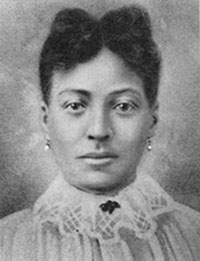
Mattie Hancock, one of five children
of Rubin and Elizabeth Hancock. Photo courtesy of Lillian
Robinson.
|
|
Rubin Hancock and his brothers were landowners at
a time when many others—Whites and African-Americans
alike—were sharecroppers and tenants.
|
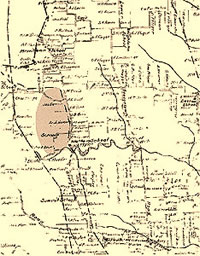
Map of roads in north-central Travis
County, 1898-1902, retraced in 1915, showing schools
and land owners (Project area, including Rubin Hancock
farmstead, is shaded). Courtesy of the Austin History
Center.
|

Aerial photo of farmstead site, 1937.
Corner of house is visible within grove of trees.
|
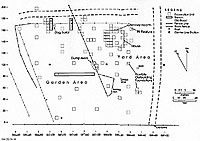
Layout of the Rubin Hancock farmstead,
as reconstructed by archeologists from TxDOT and Prewitt
and Associates.
|
|
All was created by a group of people who had just
come out of the bonds of slavery. Freedom was sweet
and they made the most of it.
|

Buttons and button hook from the
farmstead. a, shell; b, metal; c, porcelain (center
button is transfer-printed in calico design); d, glass;
e, button hook.
|
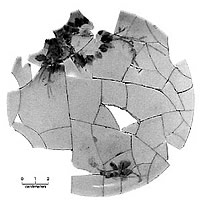
Close-up view of porcelain cup-plate
with hand-painted design.
|
|
In an area now overrun
by the busy interchange of Loop 1 and Parmer Lane in north
Austin lie the remnants of what was once a thriving community
of freed African-American slaves. Prominent in that community
were Rubin and Elizabeth Hancock who, after emancipation,
bought land, established a farm, and raised a family. Their
story—and that of their descendents and neighbors—has
been brought to life through archeological and historical
investigations.
Rubin Hancock, his wife, Elizabeth, and many
of their family members, were slaves of the prominent Austin
judge, John Hancock. Little is known for certain about their
early life, other than that they were all born into slavery—Rubin
in Alabama and Elizabeth in Tennessee—during the 1840s.
Although Texas did not recognize slave marriages (which otherwise
would have resulted in written records), it is known that
the two were married, or committed as life partners, before
they gained their freedom. More is known about the life and
philosophies of the judge. Despite his reliance on slavery,
Judge Hancock was adamantly opposed to Texas' secession from
the Union. After being elected to the state legislature in
1860 as a Unionist, he was removed from office when he refused
to swear allegiance to the Confederacy.
The1860 Census entry for Judge Hancock notes
his ownership of 15 slaves. Although none were individually
listed, it is likely that Rubin Hancock and his brothers Orange,
Salem, and Peyton were among them at that time. It is also
likely, according to family histories, that the four men were
half-brothers of the judge. Their considerable duties would
have included clearing land, planting, and working a 300-acre
dairy farm; maintaining cattle and other livestock on the
judge's extensive ranch lands; and building a variety of structures.
The end of the Civil War in 1865 brought emancipation
for slaves, announced in Texas on June 19, 1865. Sometime
after that, Rubin and his three brothers bought land in the
area north of Austin, making them landowners at a time when
many others—Whites and African-Americans alike—were
sharecroppers and tenants. With few resources available beyond
their own strength and determination— and the possible
assistance of Rubin's former master, the judge—Rubin
and Elizabeth Hancock established a productive farm, raised
a family of five children, and helped establish a small but
stable community of African-American farmers.
Known as Duval, the community was bound by family
ties and a strong church, St. Stephen's Missionary Baptist,
in which social gatherings, school classes for African-American
children, and worship services were held. The coming of the
A&NW railroad through the Hancock farm in 1881 meant an
influx of families into the area and the new recreational
resort of Summers Grove (later Waters Park). It also provided
a means of transport for farm products, such as cotton from
Rubin Hancock's fields, to nearby markets.
Life on the Farm
Rubin Hancock's granddaughter, Mable Walker
Newton, remembered visiting the farm as a child when Rubin
was in his later years. She described his home as a comfortable
house of logs and lumber siding with two rooms under the main
roof. The kitchen was a shed-type addition under a separate
roof. One room was the living room, where the fireplace was
located. Newton remembered that both rooms had big windows
with glass and wooden shutters that could be closed over them.
As was the case for many farm families of the
time, life was difficult, with seemingly unending chores for
adults and children alike. There was no running water or electricity;
water was hauled from a well, and all cooking was done on
a cast iron wood stove, for which wood had to be chopped each
day. Kerosene lanterns provided lighting for the small house.
The family raised cows and pigs, grew cotton and corn, and
maintained a large vegetable garden and fruit trees. Surplus
was sold to local store owners or sold in Austin.
According to family stories, the children found
entertainment by playing baseball, marbles, and dominoes using
handmade pieces made of cardboard. On Sundays, they attended
Sunday school and church picnics at St. Paul's Baptist Church.
Evenings often were filled with singing and socials with neighboring
friends and relatives.
Elizabeth Hancock died in 1899. Rubin Hancock
lived and continued to work the farm until well into his sixties,
leaving finally to live with his daughter, Susie, until his
death in 1916. The three surviving children, all daughters,
kept the farm until 1942, when the house was moved off the
site.
Weaving the Story
Little remains today of the small communities that once dotted
the landscape in north Austin, save for a few street signs
bearing some of their names. Over the past 100 years, northwest
Travis county has changed from a rural area to one of the
fastest-growing urban areas in the United States. When a highway
extension was planned in the area of Duval Road and Loop 1
(Mo Pac), archeologists from the Texas Department of Transportation
(TxDOT) surveyed the area for evidence of significant cultural
remains. They also examined old maps and records, and it was
through these means that they learned of the Hancock farmstead.
Using an aerial photo from 1937, TxDOT archeologist John Clark
was able to pinpoint the location of the farm and begin investigations.
On the surface, there was little evidence of
its existence, save for a well, chimney hearth, sections of
fences, and low stone walls. Excavations helped locate possible
stone piers of the house, trash areas, animal pens, and scatters
of artifacts, giving archeologists a better idea of the original
farmstead layout and patterns of day-to-day life. One of the
more poignant finds was the skeleton of a dog—likely
a family pet—carefully placed in a shallow grave.
Although more than 9000 artifacts were uncovered,
most were fragmentary. Nonetheless, careful analysis of the
many shards of glass, pottery fragments, and metal objects
revealed much about the family, their day-to-day life, and
their purchasing habits and tastes.
As Prewitt and Associates historical archeologist
Marie E. Blake analyzed artifacts and other archeological
data, historian Terri Myers set about to research family history.
Family members shared recollections and faded photographs.
Former neighbors were interviewed, and church records and
other documents were tracked down.
In a final analysis in which all archival, oral,
and archeological evidence was weighed together, several defining
characteristics of the Hancock family and farm become clear.
The family members put forth a great deal of effort to achieve
a level of equality and success, acquiring for themselves
through their own hard work a comfortable life complete with
both the necessities and some of the trappings of genteel
respectability. All of the Hancock brothers were able to own
and work their own farms. Each registered to vote and each
married and raised a family—members of which still prosper
in the Austin area. All was created by the will and effort
of a group of people who had just come out of the bonds of
slavery. Freedom was sweet and they made the most of it.
Afterward
Since the time of excavations at the Rubin Hancock site, a comprehensive suite of investigations has been conducted at the Moore-Hancock farmstead in Austin, where Rubin Hancock and his brothers lived and were enslaved to Judge John Hancock. Current landowners Michael and Karen Collins were uniquely suited to overseeing the investigation process: Mike is an archeologist with the Texas Archeological Research Laboratory at the University of Texas at Austin, and Karen is an historian. Through their efforts, the story of Judge Hancock's farmstead and the families who lived in what is now the Rosedale area of Austin have been brought to life. During the process, numerous descendants of the Hancock family, including former slaves, were contacted, and they attended the dedication ceremony for an historical marker at the site.
Credits
The account of investigations, artifact analyses,
and the history of the Rubin Hancock farmstead was adapted
from After Slavery: The Rubin Hancock Farmstead, 1880-1916
by Marie E. Blake, and Terri Myers. TBH Co-Editor Susan Dial created the exhibit in 2001 and contributed to the writing.
Blake was a staff historical
archeologist for Prewitt and Associates, Inc., at the time of this report. Her current
work includes project management, archival research, archeological
investigations, and oral history projects throughout the state.
Myers is a historic preservation consultant who, at the time
of the project, was a partner with Hardy, Heck, Moore, and
Myers, Inc. Today she heads her own company, Preservation
Central, and pursues her research interests in African American
history, South Texas architecture and history, and rural historic
properties.
Archeological investigations in the field were
carried out in 1987 by the Texas Department of Transportation,
under the direction of John Clark, Jr., who also did extensive
archival research and oral history interviews.
Lesson Plan
A five-day lesson plan based on the archeology and history
of the Rubin Hancock farmstead was developed in 1999 by Dr.
Mary S. Black of the Department of Curriculum and Instruction
at UT-Austin. Lessons focus on tracing family history, utilizing
archival resources, map-making and map analysis, analyzing
artifacts, and doing archeology. http://www.dot.state.tx.us/env/education/rhfarm.pdf/
Print Source
Blake, Marie E. and Terri Myers
1999 After Slavery: The Rubin Hancock Farmstead, 1880-1916,
Travis County, Texas. Reports of Investigations No. 124, Prewitt
and Associates, Inc.; Archeology Studies Program Report 19,
Texas Department of Transportation, Environmental Affairs
Division.
|
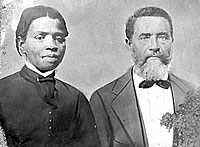
Rubin and Elizabeth Hancock were
among the first generation of freed slaves to purchase
and farm their own land in Travis County after the Civil
War. Photograph, likely taken sometime between 1889
and 1899, provided courtesy of Lillian Robinson.
Click images to enlarge
|
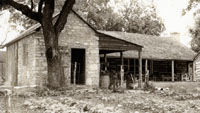
One of the properties owned by Judge
John Hancock after 1866, shown as it appears today.
Rubin Hancock, his three brothers, and other family
members were slaves of Judge Hancock prior to their
emancipation. The property, today known as the Moore-Hancock
farmstead, was excavated by members of the Travis County
Archeological Society under the direction of current
owners, Dr. Michael Collins and Karen Collins. Photo
courtesy of Michael and Karen Collins.
|

Newspaper advertisement for the
sale of lots in Duval, as promoted by one of the early
railroads in the area. The town never developed as
intended, perhaps overshadowed by activity in Round
Rock.
|
|
Section of 1910 USGS map of north-central
Austin showing the location of the Hancock farm (41TV875),
Duval, Waters Park, and other communities.
|
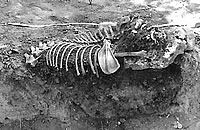
Skeleton of a dog, perhaps buried
by members of the Rubin Hancock family, found during
TxDOT investigations of the farmstead.
|

Color view of selected artifacts
found during investigations at the Rubin Hancock farmstead.
|
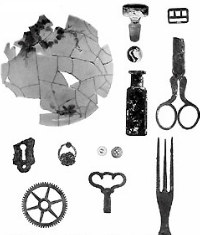
Artifacts found at the farmstead
indicated that the Hancock family enjoyed some of the
finer things in life; these items may have been purchased
in Austin or by mail-order catalog. From top, (l-r)
porcelain cup-plate, bottle stopper, buckle, marble,
proprietary medicine bottle, sewing scissors, escutcheon
plate, gold-plated pendant, buttons, clock gear, clock
key, table fork.
|
|

